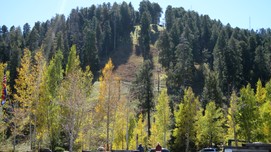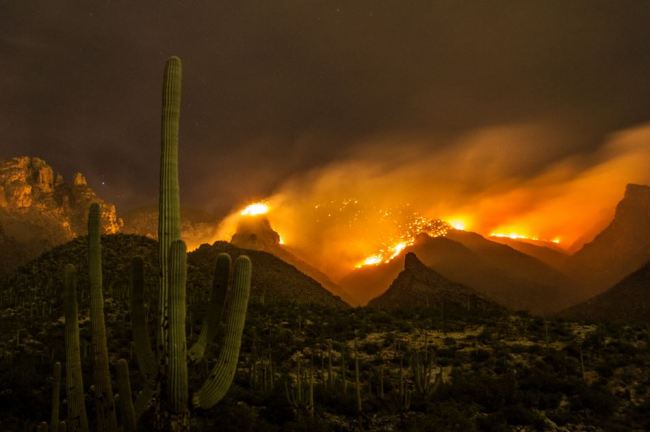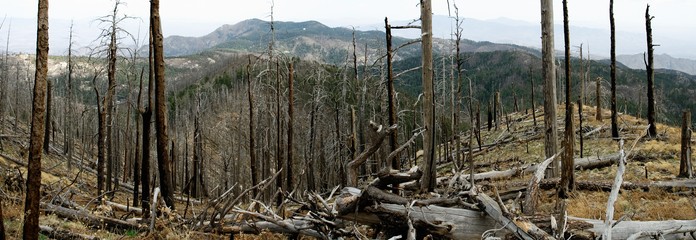One thing we learned in 1999 and 2000 was that no matter how many signs are pointing towards recession, the true pain will not start until the market participants realize all is not well. That can go on for months. It usually takes a major news event or a series of negative developments to have fear return to the market. In the meanwhile, if a new uptrend develops, our systems are designed to take advantage, regardless of the economic data.
- SEM Economic Update March 31, 2007
NOTE: The following article was written in April 2007. Given the severity of the financial crisis, it quickly became our most popular article.
In his July 10, 2016 Thoughts from the Frontline, John Mauldin used a similar analogy in discussing the current state of our economy & financial system:
Let’s draw an analogy between monetary policy and forest management. We have learned that by preventing small forest fires we actually create the conditions for large, disastrous fires that are extremely difficult to bring under control. We have found out that we should actually allow the smaller fires in order to avoid the big ones. Unfortunately, the more enlightened approach comes too late for a large portion of our nation’s forests, which in many places have become overgrown tinderboxes. Central bank monetary policy likewise suppresses the smaller corrections that prevent economic conflagrations.
With somebody like Mr. Mauldin using this analogy, I thought it was time to re-publish this article in blog format (it was distributed to our advisors via email back in 2007).]
Never underestimate the power of new highs.
Despite the overwhelming evidence that the economy is at risk of a recession and the market is due for a major correction, the stock market continues to hit new bull market highs. The Dow has already erased its bear market losses, and the S&P 500 is threatening to follow in its footsteps. New trading highs are breeding higher prices. Anybody who has used fundamental data to trade has got to be pulling their hair out.
Over the past several months, we have presented many pieces of data that showed how the strong growth phase that led the market out of the depths of recession is coming to an end. The majority of the market participants have chosen to ignore that data and are betting that the Fed or something else will keep a recession and corresponding market correction at bay. Is it different this time? Are Ben Bernanke and his jolly bunch of Fed Governors magicians that have eliminated recession risk from the stock market? We don’t think so.
The Pending Forest Fire

Let me use an analogy to illustrate. Most people that have never been to Tucson believe it is a sandy, desolate desert. I was surprised my first visit to this city to find the city is surrounded by mountain chains and is quite hilly. The climate is certainly desert like as we are already approaching 100 degrees at the beginning of May. The desert climate has led many Tucsonans to seek the cooler temperatures and dense forests of the surrounding mountains. The largest mountain chain, the Catalina Mountains, has the most inhabitable mountain called Mount Lemmon.
With air conditioning and other electric methods of cooling becoming more affordable, the desert southwest has experienced tremendous growth over the past 30 years. That growth has also led to rapid growth on Mount Lemmon.
One thing that is quite common in a forest is a forest fire. It serves to clear out the dead growth and excess plants and actually creates healthier plants within the forest. The problem is, over the past 30 years, the U.S. Forest Service has done everything possible on Mount Lemmon to prevent forest fires from occurring. If a fire popped up, they instantly put it out in order to save the many cabins and businesses that had begun to populate the mountain.

With all the excess plants, diseases began to kill the trees on Mt. Lemmon over the past 10 years. The forest service tried to stem the spread of the disease, but was not successful as a drought set in and worsened the condition of the plants. A few years ago a fire started on Mt. Lemmon. Like usual, the forest service tried to prevent it from spreading. Unfortunately, they couldn’t prevent the spread of it and half of the trees on Mt. Lemmon were burnt. The only thing that stopped the fire was the highway that snakes up the mountain. Luckily, most of the dwellings on the mountain were on the “safe” side of the highway.
The forest service spent the next year trying to thin out the remaining trees and doing everything possible to prevent another large scale fire from occurring. They were not successful. The next summer lightning sparked a fire that could not be contained. The remaining half of the mountain burned to the ground, including nearly every building on the mountain.
Much debate has occurred in Tucson about what could have been done, but the underlying theme is that the forest service’s policy of trying to squash every forest fire immediately was the cause of such a devastating fire. Ironically, if they had let some of those fires do their job—to clear away the excess—such devastation would not have happened.

So what does any of this have to do with the stock market? Think of the mountain as our economy or the stock market. The Fed is the forest service. Our economy NEEDS recessions to clean out the excesses that it naturally creates. The stock market NEEDS corrections to clean out the excesses that it naturally creates.
Think about it—
An Asian currency threatens the global economy, the Fed adds liquidity to the economy.
A major hedge fund with ties to most major banks loses billions of dollars of client capital—the Fed arranges to bail it out.
Y2K threatens to disrupt our economy, the Fed adds liquidity to keep things moving.
Did that help? Over the short-run, yes. When the forest fire finally hit and it was too late for the Fed to bail out the market and economy, the S&P 500 lost half of its value. The NASDAQ lost over 80% of its value. Some of the excesses that were created were removed quickly and with devastating effects, despite the Fed’s best efforts.
Was the recession allowed to run its full course? Nope! Banks jumped in and began offering 0% financing and no payment options in order to boost consumer spending. The Fed cut interest rates down to nearly 0%. The government cut taxes and sent nearly every family a check in order to boost spending. Mortgage companies gave nearly every family access to the housing market, regardless of their ability to repay their loans. In addition, those same mortgage companies allowed home owners to cash out the equity in their homes over and over again. All those actions not only kept the fire from spreading, it created even more excesses that need to be removed.
Like we learned in 1999-2000, nobody knows when the lighting will strike that will spark the fire that burns down the other half of the mountain.
The market is rallying on good economic news, but it is also rallying on bad economic news. The market wants to go higher. It will go higher until the lightning strikes.
Thankfully, we do not use fundamental data to make investment decisions. So why aren’t we making more money?
We are risk managers. We will always focus on risk management first, which means our systems will not be 100% invested unless all signs point higher. If there is a storm on the horizon that points towards potential lighting strikes, we won’t be 100% invested. Even if we are fully invested, our programs are not designed to capture all of the UPSIDE returns. Anybody can capture the upside. Our clients pay us to protect them from the devastating forest fire that can ruin their financial futures. A mid-range upside capture ratio combined with a low downside capture ratio means you live to survive the forest fires that will inevitably come.
Nobody knows when the fire will start or how quickly it will spread. The economic data does show that once the fire starts, it will be difficult to contain and the results could be devastating. Each of our programs offers your clients various exposure and protection depending on your forecast:
Worried about a devastating fire—Income Allocator / Tactical Bond / Cornerstone Bond / Cornerstone Income / Tax Advantaged Bond / Dynamic Income
Don’t think the fire will be that bad—AmeriGuard or Cornerstone Balanced, Growth, or Max / Dynamic Aggressive Growth
Not sure how bad the fire will be—Dynamic Balanced Allocation (or combination of models from both of the above)
If you would like to discuss how each program is designed to handle various markets, please let me know.
[Additional Comments 7/29/16: Reading some of this article it is easy to see how it could have been written today, not back in 2007. It is easy to forget how confident everyone was back then in the ability of the Fed to prevent a major fire from burning out of control.
Today, many people believe the Fed will not allow another fire to burn out of control despite the fact the Fed has taken the micro-management of the small burns to an unprecedented level. Not only did they bail out the failed banks, they have continued to pump money into them all while not increasing the regulatory scrutiny of them and allowing them to continue using the derivatives that caused the last financial crisis. Even worse, every single brush fire has been met with rapid responses. Lately they seem more concerned with stock market volatility than figuring out WHY the economy is not growing like it should be at this point. ]




